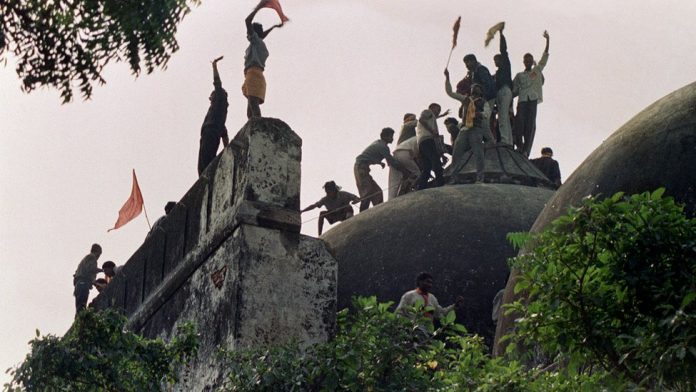By Rohit Srivastava
New delhi, (IANS): The unlocking of the Babri Masjid in 1986 that led to the “shilanyas” (groundbreaking) of the Ram Janambhoomi temple in Ayodhya and three decades of turmoil, were part of a deal between Muslim leaders and the Congress government, says Arif Mohammad Khan, a senior politician who was then in the thick of events. With the Supreme Court now calling for resolving the issue through dialogue, Khan feels that the government should take the initiative on this.
Khan said the unlocking of the Babri Masjid was a balancing act to satisfy the demands of the Hindu community after the Rajiv Gandhi government succumbed to the demands of the All India Muslim Personal Law Board (AIMPLB) on the Shah Bano case in the Supreme Court on maintenance for divorced Muslim women.
“The announcement to reverse the SC judgement (Shah Bano case) and the removal of the locks happened within a span of two weeks. This to most people appeared as a balancing act and they hoped that now both the agitating parties would feel satisfied,” Khan, author of “Text and Context — Quran and Contemporary Challenges” who broke ranks with Rajiv Gandhi in 1985 on the government’s capitulation to the Muslim clergy on implementing the Shah Bano judgement that ruled in favour of alimony to divorced Muslim women, told IANS in an interview.
“On the other hand, the removal of the lock practically accepted the disputed structure as a temple and consequently the demand to build a proper temple to carry out the functions that were already taking place inside the building gained more strength. Possibly that led the then government to agree to the shilanyas under the careful watch of the then Home Minister,” he added.
Speaking on the politics that went behind the opening of the locks in 1986, Khan said :”AIMPLB asserted that the judgement of the Supreme Court in Shah Bano is a threat to ‘Milli Tashakkhus’ that is a separate and distinct community identity, and they used very aggressive and threatening language during the agitation… But the announcement to this effect on January 15, 1986, created a severe blowback and within a week the government felt the need to do something to divert attention from the Shah Bano case.”
“At that stage, Ayodhya came in handy and the local administration — that is, the District Magistrate and Superintendent of Police — personally appeared before the District Court (Faizabad) and stated that removing the lock from the main gate of the disputed structure will not create any law and order problem,” he said.
The locks of the Babri Majid were opened in February 1986 on the order of the District Court of Faizabad.
“This to most people appeared as a balancing act and they hoped that now both the agitating parties will feel satisfied.”
Speaking on the role of Rajiv Gandhi in the entire dispute, Khan said: “After the removal of the locks, I met Rajiv Gandhi and he told me that before the lock was removed the Muslim leaders were informed about it.”
Speaking on the role of senior Congress leaders like N.D. Tiwari, Buta Singh, Arjun Singh and P.V. Narasimha Rao (who was the Prime Minister when Hindu fundamentalists razed the Babri Masjid in 2002), he said: “These leaders were of the view that the government cannot play the role of a social reformer, particularly of a minority community.”
Without criticising them, Khan said: “From one viewpoint their stand was understandable as they did not want to take any risk of diluting their political constituency.”
“In fact, I firmly hold that AIMPLB would never have succeeded in pressurising Rajiv Gandhi to do their bidding, but he was open to advice from his senior colleagues,” he added.
Talking about the role of the Babri Masjid Action Committee (BMAC), Khan referred to his earlier statements on the baneful consequences of the actions of its leaders.
“In fact I was surprised to read the autobiography of the then Chairman of Personal Law Board, Maulana Ali Mian, who has used even stronger words to deprecate the leaders of BMAC and held them responsible for aggravating the communal situation by their ‘excessive demagogy’.”
“Maulana Ali Mian has squarely blamed the leaders of the BMAC for their intransigence and held them responsible for creating a situation for ‘Hindu revivalism’ which even the most radical Hindu leaders were not capable of doing,” Khan said while referring to the autobiography.
Talking about the deal that had taken place between the government and the Muslim leadership, he said: “The fact that Muslim Personal Law Board kept itself away from Babri Masjid movement and action committee, and Ali Mian’s criticism of BMAC confirms what Rajiv-ji had said. It was only after unfortunate assassination of Rajiv-ji (in 1991), that AIMPLB also jumped into the fray and joined ranks with BMAC.”
When asked about the failure of talks during the Prime Ministership of V.P. Singh and Chandra Shekhar, he said: “During this period of time, two governors (Krishna Kant and Yunus Salim), the two Shankaracharyas of Kanchi and two AIMPLB functionaries (Ali Mian and Maulana Abdul Karim Parekh) were involved in negotiations. They met several times to find an amicable solution.”
“And if we believe what Ali Mian has said in his autobiography, then some agreement was arrived at but it could not be implemented due to the inflexible attitude of BMAC leaders.”
Asking the government to take initiative and the litigants to come to mediation, Khan said: “What we need is to be respectful to the sensitivities of ordinary people’s beliefs, and the desire to create an atmosphere where we all can live in peace and harmony in our own country. Since I am not party to the litigation I shall not like to say more than this.”


